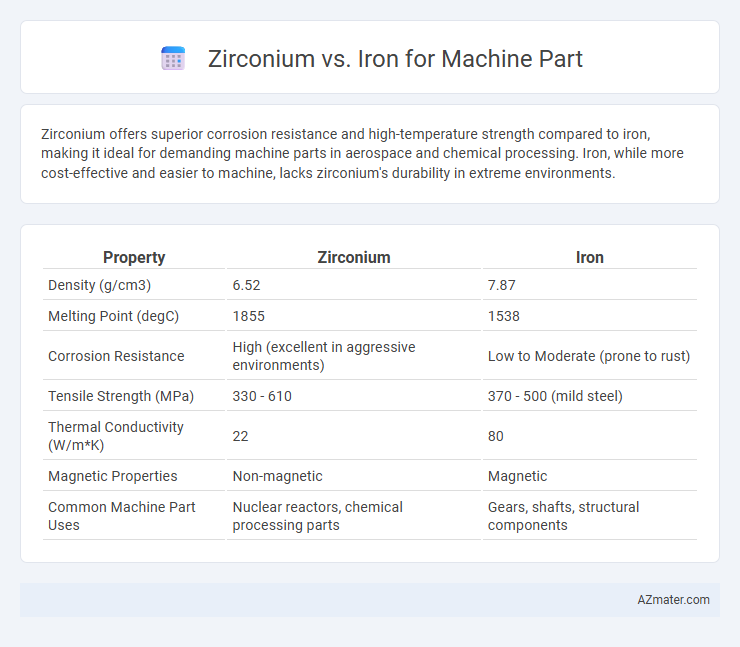Zirconium offers superior corrosion resistance and high-temperature strength compared to iron, making it ideal for demanding machine parts in aerospace and chemical processing. Iron, while more cost-effective and easier to machine, lacks zirconium's durability in extreme environments.
Table of Comparison
| Property | Zirconium | Iron |
|---|---|---|
| Density (g/cm3) | 6.52 | 7.87 |
| Melting Point (degC) | 1855 | 1538 |
| Corrosion Resistance | High (excellent in aggressive environments) | Low to Moderate (prone to rust) |
| Tensile Strength (MPa) | 330 - 610 | 370 - 500 (mild steel) |
| Thermal Conductivity (W/m*K) | 22 | 80 |
| Magnetic Properties | Non-magnetic | Magnetic |
| Common Machine Part Uses | Nuclear reactors, chemical processing parts | Gears, shafts, structural components |
Introduction to Zirconium and Iron in Machine Parts
Zirconium, a corrosion-resistant metal with excellent strength-to-weight ratio, is increasingly used in machine parts to enhance durability and performance under extreme conditions. Iron, a traditional material for machine components, offers high tensile strength and cost-effectiveness but is prone to corrosion and wear over time. Selecting between zirconium and iron depends on the specific application requirements, such as resistance to oxidation, mechanical stress, and operating environment.
Material Properties Comparison: Zirconium vs Iron
Zirconium offers superior corrosion resistance and higher melting point compared to iron, making it ideal for high-temperature and chemically aggressive environments in machine parts. Iron, with its higher tensile strength and ease of machining, provides cost-effective durability but lacks zirconium's resistance to oxidation and chemical attack. The choice depends on specific application requirements such as temperature tolerance, mechanical strength, and environmental exposure.
Corrosion Resistance: Zirconium vs Iron
Zirconium offers superior corrosion resistance compared to iron, particularly in aggressive environments such as acidic and highly oxidizing conditions. Its ability to form a stable zirconium oxide layer prevents rust and degradation, extending the machine part's lifespan significantly. Iron, by contrast, is prone to oxidation and rust, especially in moist or corrosive settings, requiring protective coatings or treatments to maintain durability.
Mechanical Strength and Durability
Zirconium exhibits superior corrosion resistance and maintains mechanical strength at elevated temperatures, making it ideal for machine parts exposed to harsh environments. Iron, while offering high tensile strength and affordability, is prone to oxidation and wear, reducing long-term durability in demanding conditions. Zirconium's enhanced fatigue resistance and lower brittleness contribute to longer service life in precision mechanical components.
Weight Considerations: Density Differences
Zirconium has a lower density of approximately 6.52 g/cm3 compared to iron's density of about 7.87 g/cm3, making zirconium significantly lighter for equivalent volume machine parts. This weight advantage improves fuel efficiency and reduces overall machinery stress in aerospace and automotive applications. Choosing zirconium over iron can enhance performance where weight reduction is critical without compromising structural integrity.
Thermal Conductivity and Heat Resistance
Zirconium exhibits lower thermal conductivity, approximately 22 W/m*K, compared to iron's thermal conductivity, which ranges from 80 to 100 W/m*K, making zirconium suitable for applications requiring heat retention. The exceptional heat resistance of zirconium, with an oxide melting point near 2700degC, surpasses iron's melting point of about 1538degC, allowing zirconium parts to perform effectively in high-temperature environments. Iron's higher thermal conductivity benefits rapid heat dissipation in machine parts, whereas zirconium's superior heat resistance provides stability and durability under extreme thermal stress.
Cost and Availability of Zirconium vs Iron
Zirconium is significantly more expensive than iron due to its complex extraction and refining processes, making it less cost-effective for machine parts. Iron, by contrast, is abundant, widely available, and cost-efficient, making it the preferred choice for large-scale industrial applications. The limited availability and higher price of zirconium restrict its use primarily to specialized components requiring corrosion resistance or high strength.
Machinability and Fabrication Challenges
Zirconium offers superior corrosion resistance and biocompatibility compared to iron, but its machinability is challenging due to its high reactivity and tendency to gall and seize cutting tools. Iron, particularly in its various alloyed forms such as carbon steel, provides better machinability with established fabrication processes, making it more cost-effective and easier to work with for complex parts. Fabrication challenges with zirconium include controlling heat buildup and tool wear, whereas iron requires more consideration of hardness and potential brittleness depending on the alloy composition.
Typical Applications in Machine Parts
Zirconium is preferred for machine parts exposed to high corrosion and extreme temperatures, such as in chemical processing equipment and nuclear reactors, due to its excellent corrosion resistance and high melting point. Iron, especially in the form of steel alloys, is commonly used for structural components, gears, and shafts where strength, machinability, and cost-effectiveness are critical factors. While iron-based parts dominate general machinery, zirconium's specialized applications are essential for harsh environments requiring durability against chemical attack and heat.
Choosing the Right Material: Zirconium or Iron?
Zirconium offers superior corrosion resistance and high-temperature strength compared to iron, making it ideal for machine parts exposed to harsh environments or extreme heat. Iron, particularly cast or stainless steel variants, provides excellent machinability and cost-effectiveness for general-purpose applications with moderate stress and wear. Selecting between zirconium and iron depends on balancing factors such as operating conditions, chemical exposure, thermal requirements, and budget constraints to ensure durability and performance.

Infographic: Zirconium vs Iron for Machine part
 azmater.com
azmater.com